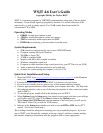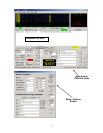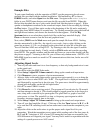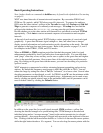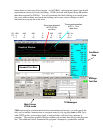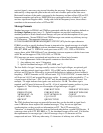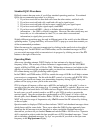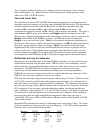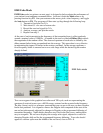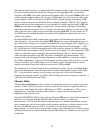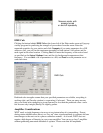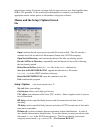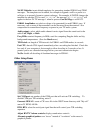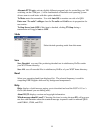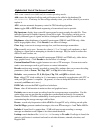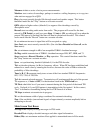received signal, a necessary step toward decoding the message. Proper synchronization is
indicated by a sharp upward spike in the red curve and a broader peak on the blue curve.
Horizontal locations of the peaks correspond to the frequency and time offsets, DF and DT,
between transmitter and receiver. EME QSOs have propagation delays of about 2.5 s and
can have significant Doppler shifts. Along with clock and frequency errors, these effects
contribute to the measured values of DT and DF.
Message Formats
Standard messages in FSK441 and JT6M are generated with the aid of templates defined on
the Setup | Options screen (see p. 2). Default templates are provided conforming to
standard practice in North America and Europe, and you can edit the templates to suit your
own requirements. Normal FSK441 and JT6M messages can contain any arbitrary text up
to 28 characters. The supported character set is
0123456789ABCDEFGHIJKLMNOPQRSTUVWXYZ.,/#?$ plus the space character.
FSK441 provides a special shorthand format to transmit a few simple messages in a highly
efficient way. Check Sh Msg to activate shorthand messages. The supported messages are
R26, R27, RRR, and 73. FSK441A sends pure tones at 882, 1323, 1764, or 2205 Hz to
convey them, while FSK441B and C use alternating two-tone sequences with the lower tone
at 861 Hz and the upper at 1206, 1550, 1895, or 2240 Hz.
JT65 messages are more constrained and must have one of three basic formats:
1. Four alphanumeric fields with specific contents as described below.
2. Any arbitrary text, up to 13 characters
3. Special shorthand messages ATT, RO, RRR, and 73
The four fields of a type 1 message usually consist of two legal callsigns, an optional grid
locator, and the optional signal report OOO. CQ or QRZ can be substituted for the first
callsign, and CQ may be followed by a space and three digits to indicate a desired callback
frequency. If K1JT transmits on 144.140 and sends “CQ 113 K1JT FN20”, it means that he
will listen on 144.113 and respond there to any replies. A country prefix preceded by “/” or
a signal report of the form “–NN” or “R–NN” may be substituted for the grid locator. For
example, –24 might indicate that signals were received at –24 dB. The minus sign is
required, and NN must lie between 01 and 30. A list of supported country prefixes is given
in Appendix A. The following are all examples of legal messages of type 1:
F9HS K1JT F9HS K1JT FN20 F9HS K1JT FN20 OOO
F9HS K1JT OOO F9HS K1JT /KP4 F9HS K1JT /KP4 OOO
VK7MO K1JT –24 K1JT VK7MO R–26 CQ K1JT
CQ K1JT FN20 CQ 113 K1JT CQ 113 K1JT FN20
QRZ K1JT QRZ K1JT FN20
The JT65 shorthand messages are powerful because they can be decoded at signal levels
some 5 dB below those required for standard messages. They do not use tight time
synchronization, so they provide no information on DT. The ATT message (for
“Attention”) is intended to help two stations find each other before a normal QSO begins. If
a message starts with ATT, RO, RRR, or 73, the shorthand format will be sent. If it satisfies
the requirements for message type 1, the full message of up to 22 characters will be
compressed and sent. With any other entry, 13 characters of arbitrary text will be sent.
6



